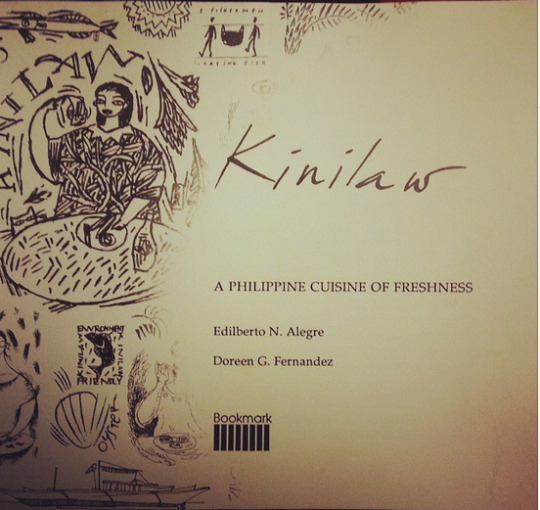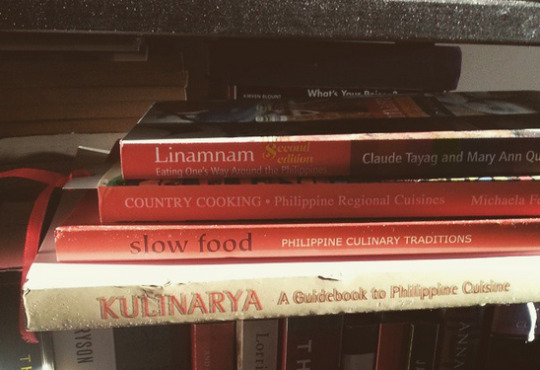Why A Trip To Seafood City Is Never Just About The Food
I think I finally get it. I get why people travel for hours to step through the doors of Seafood City.
Read MoreI think I finally get it. I get why people travel for hours to step through the doors of Seafood City.
Read MoreI'm not your typical recipe blogger, and I don't know of anyone else who writes Filipino recipes this way. I've learned to embrace it!
Read MoreI’ve become a better podcaster. I’ve been writing about food - and getting published! And I’ve been working with some incredible people/organizations.
Read More
On Friday night, after stumbling home from a party with an open bar, I opened a package from the fine folks at The Kitchen Bookstore. The next morning I saw a box ripped into four pieces. I'm pretty sure that's not how they meant me to open that. But excitement surpassed the desire to nurse my hangover, and I dove straight into "A Delicate Balance: Batanes Food, Ecology and Community" by Corazon S. Alvina and Marian Pastor Roces. This book is reflects so much of my thoughts on food these days. As I flipped through pages filled with Neal Oshima's photographs of astoundingly beautiful landscapes from the northernmost islands of the Philippines - I mumbled to myself, quietly at first, in agreement and admiration. Several times I stared at a page for some time - I could imagine myself looking over those same hills and out into the coastline. I got really excited over this book's Table of Contents page, with words like "Anyin", "Chinavules" and "Uvi" listed as chapter titles.
I will definitely have to visit.
Photo by Allan Ascano on Flickr.

Last week, I spent an hour talking to Amy Besa - someone whose passion for Filipino food surpasses that of anyone I’ve ever spoken to. I mean this in a very humbling way; it’s hard not to get swept up by Amy’s excitement over things like sineguelas, a type of sour/sweet plum harvested from what for many years was a “backyard tree” that grew all over the Philippines.
I love coming across a food item that’s mentioned in passing, then finding myself hours later spiralling down the rabbit hole of the Internet, trying to find out as much as I can about it. In the case of many Philippine fruit, sineguelas included, I usually find the best descriptions and photos from personal blogs.
I’m currently wrapping up the first few episodes of a podcast I’ve been working on called Exploring Filipino Kitchens, where I share stories about food from the Philippines told by the people who know it best.
I’ve dreamt of making this project a reality for so long, and I’m excited to share these conversations about Filipino food, with an amazing roster of guests. I would love it if you subscribed!
Maraming salamat!
Photo by Obsidian Soul on Wikimedia Commons.

Trying to figure out who I am and why it matters is a big deal, and is a big driver to the decisions I make. When I decided to visit Mindanao after 10 years of living away from the Philippines - driven by a desire to walk amongst coffee trees, leafy acres of cacao trees and fields of pineapples in their native land - I learned a number of lessons that continue to prove their value every day.
1) The only way to get there is to take things one step at a time
I enjoy cycling 24 km to work every day for the same reason I enjoyed scaling the majestic Mt. Apo - because I’m just a little crazy, and crazy enough to know that placing one foot in front of the other is the only way to get to where you truly want to go. At nearly 10,000 feet above sea level, there were certainly times when I doubted, as I have before, the decisions that led me to stand above a slippery, steep boulder face, with no other way home than by climbing down an incredible height. Needless to say, most other challenges I face now stand up to this measure; with sore muscles, a battered spirit and absolute tiredness, I made it back to base and onto other things. One step at a time!
2) Banish every stereotype you have of people to learn true respect for everyone
Every person who I met in Mindanao exuded nothing but the same kindness, warmth and familiarity I expected of Filipinos as a whole. I felt as if I’d walked into a brick wall as soon as I realized that the fear many people have of Mindanao was a fear compounded by news reports and generational tension - if my parents had Facebook and could become friends with a bunch of wildlife photographers in Bukidnon, for example, perhaps the perception of Mindanaoans as a dangerous, untrustworthy people could have been broken sooner.
Learning to accept and truly respect someone for who they are is a lesson I’m glad moving to Canada provided. Bringing that openness to my travels in the Philippines resulted in experiences I could never replicate, like hiking through a Philippine eagle reserve with a leading conservationist. And back in Toronto, the lessons come full circle - there is no place for a negative stereotype, I believe, of people you have never met.
3) Pinoy pride is real
In Cagayan de Oro, Lloyd dropped his errands to tell me about his mom’s humba (pork stew) and how it put his entire family through school; in Bukidnon, Minnie took me around her family’s ranch to visit herds of cattle grazing under a cloudless sky, flanked by towering mountain ranges; in Davao, Mel of the awesome Mel’s Food Tour spent an entire morning with me as I ate my way through the city famous for durian, inihaw na panga (grilled tuna collar), pakfry (twice-fried tuna tail) and kinilaw (ceviche-style local fish), in what she calls “the way forward by looking up roots”.
You feel it in the hearts of everyone you meet. Filipinos are proud of their culture, their resources, their environment, their food. We just have to begin a dialogue and start talking about how pride in our heritage shapes our identity.
4) Community is everything
With the isolation I sometimes feel living in a constantly moving world, being truly welcomed into someone’s home, kitchen, workplace or town hall reminded me that people are at the heart of it all.
My trip would not have been anywhere near as awesome without the generosity of Chef Chino Mempin, who invited me to family meals (Noma-style) at Restaurant Damaso; Neil Binayao, who works with the Hineleban Foundation to address food security within IP (indigenous people) communities through a “transformational partnership” model with local coffee farmers; Waway Saway, who invited me to a kinship ceremony between Moro elders, IP and modern “settlers” that culminated in a lunch of chicken tinola, pancit guisado and tons of fresh fruit with over 200 people.
5) You have to take risks to reap the rewards
I’ve been hooked on reading as much as I can about the history of food in the Philippines, and consuming every form of media I can find about regional Filipino food. In my research I found out these topics were essential to describing what’s known as “foodways” in the field of social science, or the intersection of food in culture, traditions, and history.
I hope to build a collective of individuals keen on exploring Philippine foodways - to share stories about Filipino food, their way, told from multiple perspectives and across new mediums. By collaborating with people whose expertise spans non-traditional food disciplines, I think a collective could present a new approach to understanding Filipino food.
I believe so much in the power of open data and educational resources accessible through the Internet. I’d love to connect with agriculturists, to learn about the future of crops and farming in the Philippines; with social entrepreneurs to talk about food businesses they’ve started in rural areas; with chefs and gastronomes to uncover how local Philippine ingredients drive their cooking; with historians and researchers to present their findings on food in the Philippines.
I’ve hesitated to talk about the potential of these collaborations for awhile, but the risk of these stories remaining unheard is something I can’t live with - and the reward of a community that rallies to preserve and celebrate these foodways too great!

I keep circling back to the question of why all this ruminating on Filipino food matters. I'm coming around to the realization that the best way to tell the story I want to tell is to tell it!
Why am I so obsessed with learning about food in the Philippines? Does learning about its history really help me understand my own place in world, internally and externally?
What I do feel is that I can better understand myself as the person I am and want to be, when I'm sated with knowledge about something I really care about - and I care a great deal about peoples' relationships with Filipino food.
You can examine it by class (people with barely pennies eating packaged instant noodles every single day, versus North Americans who travel to the Philippines specifically to learn about its food) or examine it by era (with research into the ingredients and cooking techniques of pre-colonial, Spanish, American and today's Filipino kitchens).
I am in the midst of planning for a 3 week trip to the Philippines in early March to gather research for my Filipino food blog. That's approximately 8 weeks from now. Alarm bells are ringing, as I've still got so much to do! I need to hammer out an itinerary, start getting in touch with people I'd like to speak with and visit, figure out how much to allocate for expenses, figure out how to get around - on top of dealing with my battered schedule at work and keeping myself in good physical and mental shape.
I am crazy excited for this trip. I look forward to setting foot in Mindanao - to visit Cagayan de Oro, Bukidnon and Davao.
Kyle from Becoming Filipino recently wrote on his Facebook page, "Next year... just take a few days. Open yourself up to the Philippines. Talk to to strangers on the street. Head out on that adventure you were debating over. Go somewhere you have never been in the country. Try something risky! Throw a SMILE on your face, bring some positive enthusiasm with you and...Let inspiration find you."
Thanks, Kulas. I hope to do just that!

One of the reasons I'm latching on to learning as much as I can about Filipino food, I think, is that through the emotional turmoil and contemporary chaos that surrounds me every day, the pleasure I derive from tasting, visually consuming, and thinking about Filipino food is something I can count on - like seeing lush, tropical forests bursting with ripe fruit across the spectrum of colour, just peeking above the horizon.
It truly means a lot to me seeing the community behind The Filipino Food Movement grow in leaps and bounds. It's what I look forward to when I open my Instagram feed, and what I tell interested co-workers about when they ask what I'm having for lunch. I love having an appreciation of the technology that enables us to reach so many people in incredibly fun, engaging ways. I love having a network of people across the world who share the same desire to learn more about themselves - as professional and home cooks - by creating and re-creating recipes that have resonated strongly with them through the years.
It's inspiring as fuck to see how we Filipinos interpret the food we clearly have a deep attachment to.
I never cared much about history as a subject matter, but find that I now have over 15 books specifically listing Filipino recipes, two collections of compiled essays from distinguished Philippine culinary historians, one 465-page book about fermented foods of the Philippines and an expanding library of general food history books and "exotic" fruit and vegetable indexes.
When I finally found steady work, I dropped the first flow of spendable cash I had on books about Filipino food, because I couldn't find the information I wanted online. I wanted to read more from Doreen Fernandez, a culinary scholar whose passion for the foods of the Philippines made me want to travel the homeland, to taste the flavours she described so eloquently.
I realized that I desperately wanted to find out how certain cooking styles became so associated with certain regions, and that I would love to share the information I find online (from archives, books, journals, and hopefully one day, field interviews).
But why?
That's a question I ask often. To me, it kinda pulls everything together. As I learned about the importance of sustainability in farming and agriculture (Sam Hiersteiner's piece at Lucky Peach is a good primer), it made me think about the abundance and sheer variety of Philippine produce. What types of solutions might exist around utilizing those resources to boost the image - and consequently, consumption - of Philippine fruits and vegetables?
As I read about the importance of food security both in Western and non-Western societies, I thought about the state most Filipino farmers currently find themselves in - struggling to stay above the poverty line on a good season, penniless on the off. Farming is done in the rural provinces, where accessible educational material for things like root crop rotations and charts to document rice harvests are scant, and still very much needed.
I want to keep learning because it spurs my interest, and encourages me to write about Filipino food from different viewpoints.

As my love and understanding of the foods of the Philippines deepens, I find it stirs a great well of belonging in me - something I have spent a lot of time looking for.
I'e confessed of my desire to write about Philippine cooking in the context I find most interesting: culinary history. Learning as much as I can about the history of the Philippine islands - of the abundance of native produce in its lands, paired with the ingenuity of cooks who came to understand what their ingredients were capable of - is an ongoing mission. My goal? To share the striking beauty of the Philippines and its cuisine, by reporting on what culinary traditions exist, how they got there, and why it is necessary to document these techniques and practices before a generation of cooks so attuned to their environments across the Philippine islands, disappears.
Like many people of my generation - Filipinos and non-Filipinos - my attention span is short, and I wish I had the seemingly boundless energy that incredibly successful people have with their work. I have trouble defining what's important to me, and following the general rule of growing up I've found that my priorities shift as time passes - not always in the upward direction of advancing your career, pay scale, apartment size or wardrobe quality - but in a linear pattern too, where I'm thankful to realize that to grow as a person, you need to build character and resilience, to develop confidence and belief in the things you do.

I've just returned to Toronto from a week in beautiful Prince Edward County, holed up in an off grid cabin along Adolphus Reach in the town of Picton.
I tease my boyfriend that he has now turned me into a wine snob - three of the last five days have been spent cycling along the county's wine route, hopping off our bikes every few kilometres to sample an incredible array of reds and whites, falling deep in love with the crisp finish of County Cider's delicious apple ciders and the diversity among local winemakers' Pinot Grigio wines, produced from grape varietals that thrive in this region of Southern Ontario.
Just before we left for this trip, Iain and I attended NextDayBetter Toronto, followed by the first seating of Yana Gilbuena's SALO Series pop-up dinner at The Depanneur. Eating with our hands, kamayan-style, we enjoyed bringhe (a Philippine version of paella) made with black rice and topped with milky, head-and-tail-on shrimp, plump baby squid and a halved century egg; oxtail sisig, bursting with the unctuousness of stewed, sauteed oxtail in soy sauce and aromatics, shredded and so savoury with a hint of capsaicin from chopped finger chilies; slices of balimbing, known in North America as carambola or starfruit, dusted with sea salt; kalderetang itik, or duck stew; callos, a dish composed of beef tripe simmered in a sweet pepper, chorizo and chickpea-laden tomato stew, bursting with umami in every bite paired with a piquant olive relish; and for dessert, Yana's mais con hielo inspired turon, with freshly shucked kernels of sweet Ontario corn.
The last week has gone by in a blur of delicious food and drink!
Despite the gustatory excitement and vacay fun of the last 7 days, however, I find myself sitting here still feeling like there's something I need to do. Today I read a blog post from Gelaine Santiago of ChooseSocial.ph, whom I had the pleasure of meeting at last week's NextDayBetter event.
Perhaps it's a bit of a siren call that I desire, along with many others I've met through NextDayBetter, to learn more about ourselves by understanding the challenges and opportunities faced by the Filipino diaspora worldwide.
"What I learned more than anything that night is the beauty and power of storytelling," Gelaine shares. "And more importantly, of vulnerability. By being open about our fears and hopes and dreams, we unconsciously allow others to do the same."
After meeting Yana, Carl of MeriendaTO and the food presenters at NextDayBetter Toronto, I'm encouraged to continue research on regional Filipino food and its history, in the little ways I can.

Today's rainy Friday is best summarized by this song, courtesy of Mac Demarco's crisp guitar picking while he sings about a lazy day and the people in his home. But going back to this post's title, we made a nice big pot of balatong last night, commonly known amongst Tagalog folks as monggo guisado. A great, pantry-staple friendly dish to whip up for a movie night at home.
Etymology
Monggo guisado's roots begin with the word gisa, which is Tagalog for saute. The argument for what constitutes essential ingredients used in pag-gisa (or the act of sauteing, i.e. gisa as a verb in the present tense) will forever be a point of contention between various Philippine provinces, thanks to the variety of locally grown ingredients found across the Philippine archipelago.
To my mind, being from the southern Tagalog region (encompassing the city of Manila), a truly great gisa starts with the low, slow caramelization of fresh, floral garlic and minced Spanish onions.
The key to making incredibly flavourful monggo guisado begins with understanding the Maillard reaction, or how the careful browning of garlic and onions over consistent heat unlocks a cascade of flavour profiles from two Filipino food staples.

What story has entranced us so much as the Philippine mango? I feel like anecdotes from many people can be told, and if permitted to begin telling, I would love to share one of those that hold dear to me.
I adore mangoes. Fresh, canary yellow, plump orbs of fruit, elongated with a sexy curve that guides your ring and pinky fingers to nestle a ripe Philippine mango snugly at the base of your palm. I remember the smell of peak season carabao mangoes erupting from opaque green bags, soft plastic just lightly crinkling as you shift pieces around, the sweet essence of a mango picked at its height bursting forth. For a moment, it made the very real scene of five people with their noses positioned tightly together around a bag feel like an afternoon spent in a backyard bukid (farm) with a creek gushing nearby, in the Philippine countryside, on a May summer day where everything else in the world can fall apart except the mango trees.
The trouble is, I don't think I ever spent an afternoon in the Philippine countryside enjoying fruit in a backyard farm, because like hundreds of thousands of city-reared children, I spent a lot of my childhood indoors, reading and hanging about, surrounded by people of varying ages, wandering into the kitchen to eat whenever I felt bored.
Boredom fuels a lot. It fuels your desire to dream about what you want to be as an adult, and in the intervening years from being a surly teenager to a somehow-functioning twenty-something, you spend time thinking about what your priorities are.

This long weekend has proven to be quite therapeutic for me. Cliched as it is to say, I can see the light at the end of the tunnel. People write routinely about the changing of the seasons for a reason. The sunlight encourages me to be outside, to bike around town, to cook, to spend time with the boys at home. I really want to take a stab at writing this book that I so clearly envision making. The first step is to really take a close look at outlining what I want to do, in a documented form to show I'm not just made of ideas, with an execution plan. Second, to verbalize my thoughts and see what other people think of them, to speak with an agent and other writers. And from what I've read, the one thing I need to be absolutely sure of is the determination involved with a project of this scope. This is not going to be a weekend thing, I'm going to have to really devote a lot of time and give up quite a bit to want to do this - and whether I really want it that much is a question that can understandably linger in your mind.
I'm going to have to put career advancement - or jutting from one career path to another, at the very least - on hold if I really envision that book materializing. And I have to be happy doing it, happy with the job I spend much time in, serious about planning a research trip to the Philippines. I need to let go of the regret and blame I feel for fucking up the last year or so, of being naive and quitting a job (two jobs), and having the guts to see what I could do; failing, ultimately, and taking me to where I am right now - listening to music that reminds me of summers back home, smoking cigarettes in my bedroom and thinking about what life would be like in Canada, imagining doing the activities I do today would be the norm of every day.
Life throws curveballs often, and getting to the conclusion that you need to adapt - to sink, or to swim - becomes, you hope, inevitable.

I feel compelled to write about how I feel - about why my generation of globally-plugged in Filipinos love our food, but generally slide on the actual cooking part - but feel like I'll want to cover so many points that I don't even know where to begin. "Ang hindi marunong lumingon sa pinangalingan ay hindi makakarating sa paroroonan." "He who does not know how to look back upon where he came from, will never reach his destination." - Jose Rizal
Talking to my family always provides much-needed perspective - sometimes, incredibly needed ones, on days when I feel like absolute shit, on a day like today where I was *this close* to buying a pack of cigarettes that I've managed to avoid for just over two years (well, I've lapsed on the smoking part a couple of times, but have not purchased an entire pack since).
This week, an article from the Washington Post titled "At long last, Filipino food arrives. What took it so long?" made the rounds on all my social feeds, with lots of conversation around it. And I will admit that reading it earlier today, prior to meeting my lola for breakfast, hit me in so many ways - I nodded in agreement with acknowledging the "hiya" factor on Filipinos' acceptance of Filipino food as a whole, and bobbed my head with vigorous enthusiasm on Filipino food channeling "spice, sourness and pungency, three of the trendiest flavors in American dining."
I feel incredibly fortunate to participate in the Filipino Food Movement sweeping the globe, slowly but steadfast and sure in its pace, particularly when an article about four trendy Filipino restaurants opening in D.C. appears in my reading list next to a piece about "kaldereta a la pagpag" - kaldereta being a tomato-based meat stew, in this version made with chicken flaked off of previously consumed pieces of fast-food leftovers.
It breaks my heart, and the hard part is knowing that this middle ground where I feel like I'm straddled between two worlds, not knowing what to do, never seems to go away.
I'd love to write about what Filipino food means to me, from the perspective of someone who grew up loving it but always shelving that love beneath the pedestal of Western cuisine - and now realizing how robust the subject of Filipino food really is. The variety of ingredients and cooking methods across the Philippines could take decades to document in its scope; the cuisine's history just as long to research; its cultural influences, regionality and seasonality leaving much room for discussion and study; its flavours and textures ready to be broken down and reconstructed not as trendy fusion food, but in essence as a reflection of how Filipinos have adapted to their environment through time.
These stories could take years to understand, with countless stories to tell.

As I mused about an appropriate title for the subject matter I wanted to write about - surrounding new chapters in life, my fledgling career and growing into the person I would like to be - the word kasaysayan, a Tagalog word for 'history,' popped into my head. With the snap of a gnat sucked into an electric insect killer, I wondered, how have I not thought about this word before? We all write our own histories, day to day, with the things we put conscious effort into doing. We learn to accept the decisions we make, because really, how are we supposed to know any better until we try something new? (And either fail miserably with our goals, succeed with determination, or just get plain lucky.)
I've just started reading Dianne Jacob's Will Write for Food, which I also can't believe I just picked up - it's such an incredible resource. In the first chapter she asks, "What's your reason to write about food?" and I found the following points spot-on:
This is why I've treated myself to ordering topically-relevant books every other paycheque, and why I spend the precious quiet hours of 3 to 5 a.m. on Tuesday and Wednesday nights reading entries from Proceedings of the Oxford Symposium on Food and Cooking about things like budbud kabug, a sweet, steamed millet cake made with coconut milk traditionally wrapped in banana leaves.
I also finished reading Michaela Fenix's Country Cooking this week; paired with watching Kyle Jennerman's adventures in Mindanao, it's making me want to set an alert for seat sales from YYZ to DVO!
Setting foot in the places I would love to visit, to explore the culinary histories and everyday foods of locals in incredibly diverse regions of the Philippines, would be fantastic and beyond exciting. It will involve a lot of work, and require a lot of help from anyone willing to lend a hand. But as Katherine Viner argues in this home-hitting piece on journalism in the age of the open web, this a ripe, wonderful age for storytelling - in whatever form best suits the story, for readers who care and want to be involved with how history plays out - in my corner of the Internet, for a better understanding (and documentation) of the history of regional foods in the Philippines.

So this is what happens with working overnight shifts. You find yourself wide awake at 5 a.m. on your days off, with your brain ready to run at full capacity and your senses and faculties completely tuned into whatever it is you decide to do. Also, it's wonderfully quiet. I certainly don't come across these situations often. I received two Filipino food books in the mail yesterday - one about the Philippines' interpretation of ceviche, Kinilaw: A Philippine Cuisine of Freshness by Edilberto Alegre and Doreen Fernandez, and a book called Coconut Cookery of Bicol by Honesto General, shipped by the good folks at KabayanCentral.com.
Here is an excerpt from the preface of Kinilaw:
"When this book began, we only had our meagre experience of kinilaw to guide us - stealing shrimp from fish pens in Victoria, Tarlac, and having them with salt and kalamansi right close to the baklad (traps); crunching brown seaweed with vinegar, tomatoes and onions in Silay, Negros Occidental; serving deboned raw dilis in celadon shrimp cups as an aperitif; partaking of four kinds of kinilaw in one sitting at a Dagupan bar; being offered by a Maranaw market vendor the kinilaw she had made in plastic bags while using a pile of soft drink cases as a table; watching in surprise as a favourite carinderia vendor in Cagayan de Oro's Cogon market suddenly darted out to persuade a passerby carrying a bag of barilis (yellowfin tuna) slices to have her prepare his kinilaw; and hearing Vic Fuentes, Dumaguete restaurant owner and food philosopher, explain about vinegar "cooking" raw fish and changing its texture from translucence to opacity.
From these we identified the distinctive qualities of the kinilaw itselfn- the freshness, the sweetness of the raw - and of the process "cooking not in fire, but in liquid fire".
I am so excited to dig in!

Absolutely LOVING this book!

Filipinos are nothing short of astounding at utilizing local resources to meet their daily needs. Shelter, clothing and food translate to nipa hut (palm tree) houses built with lumber from fallen trees, garments woven with textiles produced by local craftsmen, breakfast, lunch and dinner prepared using ingredients local to each community. It's an idyllic, ideal description of what life in the Philippine countryside portrays, reported through essays in newspapers and magazines, and told through stories from people who recall what their hometown, or their parents' hometown, was like.
I think about why these stories have taken such a hold on me, someone who spent the first 19 years of her life living in the cloisters of Manila. I think about why, amongst everyone I grew up with as a middle-class kid who dreamt like many others of travelling, I envied people from Europe and North America for having a passport that could take them anywhere they wished. I imagined whisking off to ancient walled cities with towering Grecian architecture and sitting in a piazza in northern Italy, sipping a robust espresso, pages open to a favourite book.
I never really dreamed about visiting other places in the Philippines, my home country - and I feel strongly about wanting to change that. I long to travel the Philippine islands and share my enthusiasm with what I learn about - products and foods I come across that reflect an intense understanding of regionalism, and with the people and communities I look forward to meeting, more than anything.
Last week, my shipment of books from Anvil Publishing arrived (they are fantastic with international orders!). I was ecstatic at finally getting my hands on a book called "Country Cooking: Philippine Regional Cuisines" by Michaela Fenix, noted food writer and journalist. The book is a collection of essays from her weekly column with the Philippine Daily Inquirer.

In the span of 62 pages, I have travelled to Aklan, Angono, Baler, Bataan, Batanes, Batangas, Bicol, Binondo, Bohol, Bulacan, Cagayan de Oro and Cagayan Valley - learning about the culinary specialities of each region, a little bit about the history of each town, living through Fenix's words to plop myself right in the middle of a lechon-fueled fiesta, or by the sea netting crabs with rich talangka (crab fat) that melds beautifully with coconut cream - think of deep, intensely orange roe melting right into a milky white sauce spiked with chilies and shallots, redolent of floral notes from the coconut's first press.
It makes me shiver just thinking about it. Somehow, these foods will make their way from a printed page into my mouth, and back out onto a screen to convince at least five other people that embracing your Filipino-ness a little more can start with appreciating the diversity of regional Philippine cuisine.

I have been, quite literally, thinking about dinner for a long time; from distinct memories I remember attributing to about fifth grade, I have thought about dinner whilst on my commute home, riding in suspension-challenged tricycles, crowded jeepneys, open-air buses, planes, streetcars and still-crowded subways.
Dinner has always held a special place in my heart, cheesy as it is to say. When we lived in my grandmother's house in the Philippines, people at home would often eat dinner together. In the dining room we had a large, round wooden table lined with cloth and a glass top; that table, which I loved, did not leave much room for passing through to the kitchen when all six spots (easily extendible to eight) at the table were taken.
On these various ways home, the idea of thinking about what I would soon have the pleasure of sitting to eat sustained me through what often were long, arduous commutes.
Philippine condiments, on the other hand, I've thought of more intensely over the last two days than I've ever accorded them. As I sat to eat another bowl of sinigang with sweet bagoong (sauteed fermented shrimp paste), I thought about the types of bagoong I've had the chance to eat - and quickly realized that I didn't really know much about the process of making bagoong, a condiment I unabashedly love and cannot live without.
So off I took to research - and found some excellent sources.

In the grand scheme of things, what I write and think about doesn't matter. But often, writing has proven to be the strongest ally I have with communicating ideas, frustration, and the emotional states I find myself in.
I have a tendency to beat myself up over the outcome of things both within and beyond my control; something I'm aware of, and learning to get better at handling. I regret that I quit a well-paying job in a field I love, because of principle, and because I was confused and needed to pursue what I knew I could professionally achieve.
The real world hits you back hard, though, and after almost six months of trying, consistently, to gain equitable employment, I'm close to chucking my career aspirations out the window. I need to talk about how much I love content, and great writing, and passionate people, but I also need a job that puts a roof over my head and makes me feel validated, if even in the basic ways I need to feel now.
I've read countless articles, blog posts, and updates from people online who talk about pursuing your goals - which I still intend on going for, given the opportunity.
I made pancit guisado on Saturday, a staple of the Filipino cooking cannon that I've never prepared myself - noodley goodness loaded with succulent pork, shrimp and tender-crisp vegetables, tossed with the savoury depth of soy and oyster sauce. It was fun, and produced a deliciously large plate eagerly consumed by three. I blanched the pancit's veg components separately - matchstick carrots, snow peas, and crisp green beans - for a minute, dunked them in an ice bath, then set aside for tossing with the noodles and shrimp in the last minute of cooking. A great technique to prevent soggy, sad vegetables in the final dish.
My dinner companions have been incredibly patient with me throughout this period of self-doubt, work-searching and general deflation of personal worth and confidence. I've considered these weekly recipe projects a welcome respite to the arduousness of job hunting - hopefully, to result in a greater good.
Photo via Pulaw on Flickr.

I made cookies for my birthday and then wished I could just send a couple batches to people on the other side of the world. I know, I get incredibly sentimental over things like food, love and identity; which, by no coincidence, are things I have recently spent a lot of time learning and thinking about.
Sentimentality is a trait shared by many Filipinos, in varying degrees. It is certainly something built into my core, outwardly demonstrated by my love of guitar-driven classic rock, highly introspective characters in books and snuggling up to watch Freaks and Geeks from beginning to end.
I used to regard the feeling of being sentimental as something I could leave behind with my old self from Manila; with the ridiculous amount of things I needed to do to become an assimilated Canadian, dwelling over how I felt about personal changes seemed an inappropriate use of my time, particularly when I needed to rush between classes, a 20 hour per week job and balance side projects, chores and making time to visit friends.
In light of what the last few years have been like, taking time to assess my personal and professional goals and drawing plans for achieving those goals seem like an alright use of my time.
Photo via Lars Plougmann on Flickr.